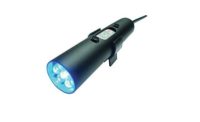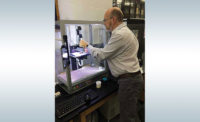Carbon-fiber composite materials have been the darling of the aerospace industry in recent years. But, metal still plays a critical role in commercial and military aircraft, especially for applications that involve high temperatures or high stresses, such as engines and landing gear.
Engineers at the Air Force Research Laboratory (AFRL) are exploring new metals and new metal processing techniques for use in hotter, faster and more efficient aircraft and spacecraft being developed for future combat missions.
“Until you can make a jet engine out of anything else, metals will be important,” claims Michael Burba, Ph.D., an AFRL materials scientist. “Lightweight composites now make up a bulk of planes’ outer skins and great weight reduction and efficiencies have been made through this, but there is still a need for metal components.
“For instance, 15 percent of the structure of a 787 jetliner is titanium,” notes Burba. “And, metal still reigns supreme for military applications. Most advancements come from reducing maintenance and increasing the life cycle of critical engine components that are all made with metal.”
To address the important role played by aluminum, beryllium, titanium and other materials, the AFRL recently created a Metals Affordability Initiative (MAI) to engage suppliers. The goal of the collaborative effort is to ensure the continued advancement of metal technologies that result in lower costs and more efficient production processes. The MAI is comprised of eight OEMs and seven suppliers.
“Members represent all stages of [aerospace] metal work,” says Burba, who serves as MAI program manager. “What has made MAI so successful is the precompetitive, active participation of its members, along with the cost share each brings to the projects. This guarantees the technical
projects inside MAI have real-time benefits to the war fighter, as well as commercial markets.
“Companies are free to share ideas without the pressure to take research to a level at which they would be risking intellectual property,” notes Burba. “Rather, they are given access to research funds that allow them the freedom to think outside of the box for the good of metals technology as a whole.”
Engineers focus on a variety of issues and challenges, such as minimizing defects during the manufacturing process and identifying risks after parts have already been in service. One recent project simulated titanium cracks by examining various production methods.
“By testing this assessment tool, [we can] take a newly created piece of titanium and predict if a crack would form and how long it could be used before the crack would compromise it,” explains Burba. “The success of these programs [has had] a direct effect in lowering the cost and man-hours in inspection, replacement and repair of flight-critical parts. [It has also laid] the ground work for more in-depth tests to be performed once these assessment tools can be shared [within the military aerospace] industry.
“Jet engines and airframes are an important need in the Air Force, but the focus of MAI isn’t to make the next fighter jet,” Burba points out. “Every year, the Air Force provides a list of key issues that [it] needs metallic materials to be able to handle.
“MAI work focuses on creating tools and practices that each individual member can take back and then use in their own internal processes,” says Burba. “Advances can [range] from basic construction applications to insertion into high-tech spacecraft components.
“Consistency and repeatability are key issues for MAI,” adds Burba. “Creating practices that will produce results that are all similar to each other and behave in a predictable manner is a cornerstone of what [we] try to do. Work on traditional processing, as well as new additive manufacturing processes, have all revolved around these areas.
“Assembly-related work focuses on residual stress or how materials warp and change at a microstructure level after they go through manufacturing processes such as forging,” says Burba.




